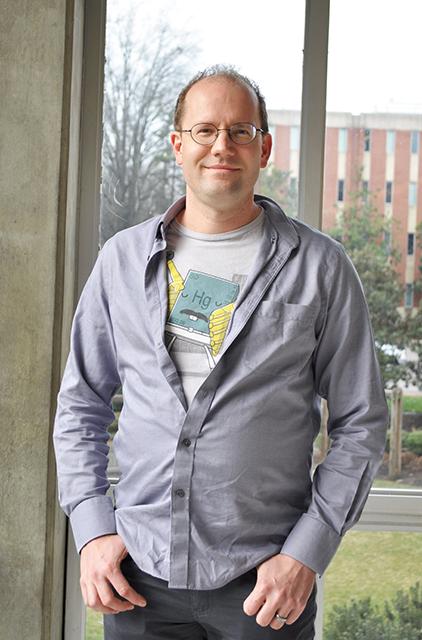
Elizabeth Davis
Through experiment.com, chemist Walter Weare is using crowdsourcing to raise money for his research. The donations will be used to aid in the discovery of a new molecule to improve LED lighting. Photo by Elizabeth Davis
Crowdfunding has become increasingly prevalent as a way to fund small businesses and other projects during recent years. Sites such as Kickstarter, Indiegogo and others have allowed small teams to raise awareness and gain funding for innovative technologies and artistic endeavors alike.
Now the crowdfunding movement has branched into scientific research.
Walter Weare, an assistant professor of inor ganic chemistry, has recently started a crowd funding campaign using a new website called experiment.com to raise money for his team’s research about creating new molecules for or ganic light emitting diodes, or OLEDs. Ex periment.com, formerly known as Microryza, is a startup built to fund scientific research.
This research is not Weare’s first foray into crowdfunding, as he previously funded an other experiment through a different web site a few years prior, as part of the SciFund challenge.
Weare’s current research emphasizes the creation of a “greener” process for OLED production. According to his project’s crowd funding page, Weare is developing a new method for creating OLED materials that is “both technically simpler and creates less polluting byproducts than the current ways used to manufacture similar light-emitting compounds.” His method uses oxygen as the only extra ingredient in forming new carbon-carbon bonds, eliminating a great amount of the waste produced by other methods.
“The ways that other people make the same types of compounds are multiple steps where you get groups that you have to throw away at the end. In ours, the only waste is really if our reaction doesn’t work,” Weare said. “But it’s all only carbon and oxygen, so you’re not throwing away heavy metals; you’re just mak ing tar.”
Different methods of production often make for different varieties of OLEDs, with some emitting more light in a particular wavelength than others. Weare’s initial tests produced a very bright orange emitter, which he said was unusual for the organic variety of LEDs. This uniqueness could pave the way to an application for the new molecules created through his process.
“The main properties that people look for is what wavelength of light you’re going to get and how efficient [the OLEDs] are at do ing that. So if we’re thinking about lighting people want white light, and a broad energy spectrum,” Weare said. “If you’re going to be using them in TV screens, you want to have the three channels that make up a TV: red; blue and green.”
After explaining applications of existing OLED technology, Weare began to explain how his research was more of an academic pursuit rather than a means to create a spe cific product.
“We want to develop a new way to make these bonds, and whatever we make at the end is interesting,” said Weare. “That allows us more freedom than someone in an OLED company, since they have to put out a product. In an academic setting, we’re more interested in learning.”
Weare, however, said when talking to a non-scientific audience, such as with crowdsourc ing, one should talk about possible applica tions, even if the research is very far away from that point. Otherwise, the majority of people who hear about the research won’t know why to be interested. With this crowdsourcing ap proach, it’s important that Weare be able to communicate his vision on a level people can easily support.
“My purpose is to get the word out and have people understand a little more about organic chemistry and how you link compounds to gether, and then for them to hear back from us and say, ‘Here’s the paper that we wrote based on your help,’” Weare said.
For those interested in reading more about Weare’s research, visit www.experiment.com/ ncsu_oled.